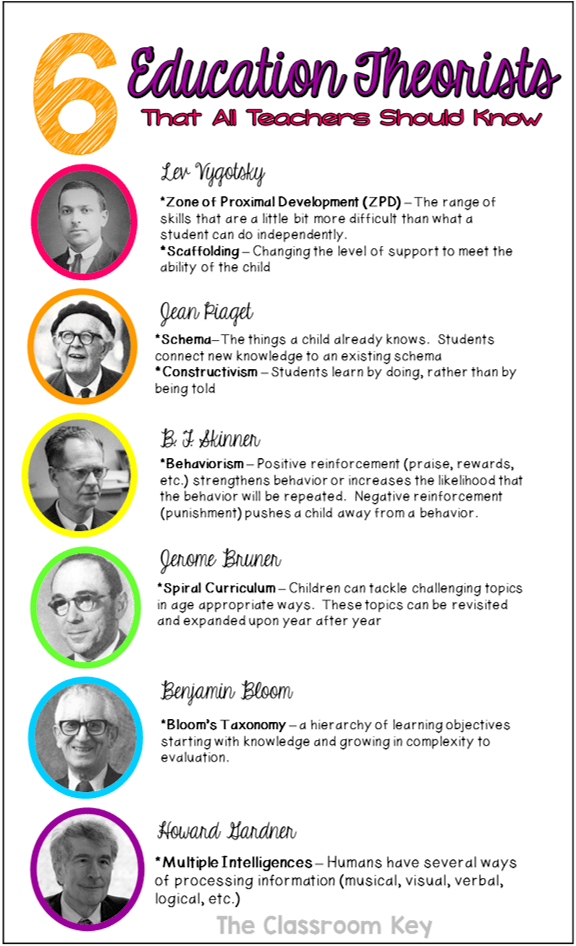6 Education Theorists
- 6 Education Theorists Like
- 6 Educational Theorist
- 6 Education Theorists Get
- Famous Theorists In Education
- 6 Education Theorists
Learn education theorists with free interactive flashcards. Choose from 500 different sets of education theorists flashcards on Quizlet. Research the theories explained here and compare and contrast them. Find out what other relevant theories there are. Use textbooks and journals, or key the words ‘learning theories’ into an internet search engine. Knowles, M, Holten III, E and Swanson, R (2005) The Adult Learner (6 th ed.). Oxford: Butterworth-Heineman.

This fact makes the psychological constructivism valuable in its own way, even though it (and a few other learning theories as well) may seem to omit mentioning teachers, parents, or experts in detail. So do not make up your mind about the relative merits of different learning theories yet! There are 5 overarching paradigms of educational learning theories; behaviorism, cognitivism, constructivism, design/brain-based, humanism and 21st Century skills. Below, you will find a brief outline of each educational learning theory, along with links to resources that may be helpful. The Six Famous Curriculum Theorists 1. Franklin Bobbit (1876-1956) Bobbit believes that the learning objectives, together with the activities, should be grouped and sequenced after clarifying the instructional activities and tasks. He also views curriculum as a science that emphasizes the needs of the students.
ADVERTISEMENTS:
This article throws light upon the six important theories of transfer of learning. The theories are: 1. Mental Discipline 2. Identical Elements 3. Generalization 4. Transposition 5. Ideals 6. Learning to Learn.
Mental Discipline:
This theory came to existence in 20th century. It is philosophical in nature. Mind is the central position which is composed of several facilities. These faculties are to be trained through muscular and physical training. This facility psychology developed during 1734.
The diagram below explicates the theory of mental discipline:
From the above diagram it is known that bright students learn better than that of slow learners because memorization is more faster in length students where as slow in slow learner.
Identical Elements:
E.L. Thorndike has developed this theory. It goes from on learning situation to other situation. Two identical factors or activities or common factor transfer to total situation where maximum transfer of learning or total learning can be taken place. It goes from matter to mind.
Identities of substances:
Identities of procedure → Total result
Matter → Mind
Exp — Piano → Typing/Computer
Sanskrit → Hindi
6 Education Theorists Like
Latin → English
Car Driving Bus Driving
Generalization:
This theory is developed by C. Judd. In this theory transfer of learning takes place primarily through generalization and degree of transfer depends upon the extent to which experiences in the first situation are understood and consolidated into generalization.
Better transfer can be possible when one can understand the principle. It is just an extension of the theory of identical elements. General principle Specific solution Laws of refraction More significant One situation —> transfer other superior situation. It is a fact that when practice of anything is made without training, then result comes within automatically.
Transposition:
It is advocated by Gestalt psychology. Transfer starts in understanding the fact and perception of similarity by the learner. It is known as pattern of relationship. It is not the specific skills or facts or even underlying principles which are important, but the understanding of relationship between facts, process and the principles are the real basis of transfer.
6 Educational Theorist
6 Education Theorists Get
Ideals:
It was propounded by W.C. Bagley. When ideas are stressed are perused then transfer of learning can be taken place. Ideas like honesty, truthfulness, love etc. can be transferred in this theory.
Famous Theorists In Education
Learning to Learn:
6 Education Theorists
After practicing a series of related or similar tasks then learner learns the capacity to learn the same thing. It is found that whenever learner comes in contact with various learning materials then he learns efficiently and effectively. Learning to learn means when learning starts from one method then it goes to another method.